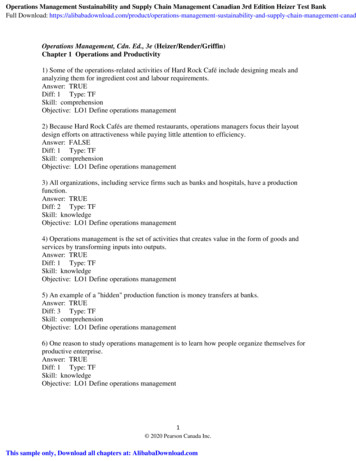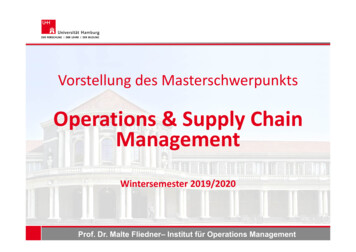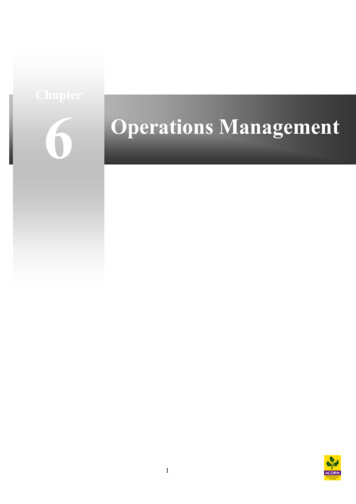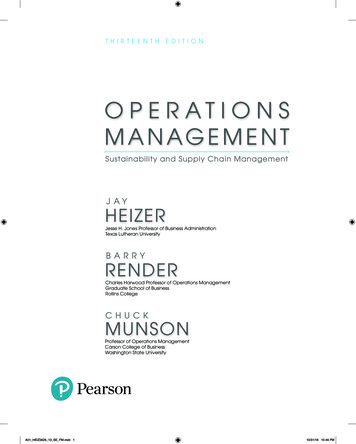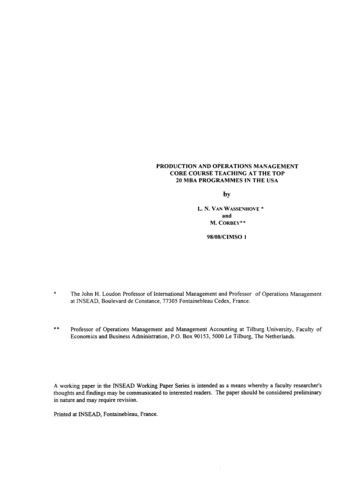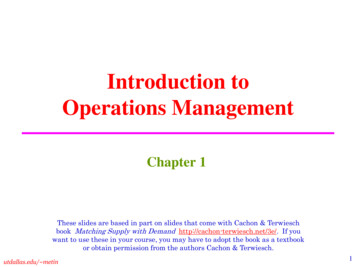
Transcription
Proceedings of the International Conference on Industrial Engineering and Operations ManagementBandung, Indonesia, March 6-8, 2018Analysis of the Operations Management Strategy of aTelecommunication Company in MalaysiaHabibah @ Norehan Haron, Nabihah Hashim, S Umeesh Kumar Suppramaniam,Fazarizul Hashidi Bin Muhamad Pauzi, Suriya Narhayhanen @ Subramaniam RamaNaiduRazak School of Engineering and Advanced TechnologyUniversiti Teknologi MalaysiaJalan Sultan Yahya Petra, 54100 Kuala Lumpur, Malaysiahabibahharon.kl@utm.my, nabihah@tmrnd.com.my, umeeshcom@yahoo.com,fazarizul.hashidi@gmail.com, suriya5@live.utm.myAbstractThe transformation of telecommunication industry in Malaysia has seen dramatic changes in the lastdecade. This industry provides high speed data, voice services, graphics, television, and video atincreasing speeds and through diversity of channels. While fixed-line telephonic communication is stillthe core service mode, wireless communication, internet, cable and satellite program distribution areimproving their share in the overall industry earnings.To sustain productively in this industry, operationsstrategy and critical decisions are important aspects of operations management. This paper reports theanalysis on the operations management strategies of a telecommunication company (named TC) inMalaysia. The current challenges that play an important part in deriving and developing effectiveoperations strategies to be in line with the mission and vision of the organization are identified. Analyseson the company’s strengths, weaknesses, opportunities and threats (SWOT) and the factors affecting thecompany mission provide the necessary information in helping the company management to make criticaldecisions in developing its operations management strategies. The final section discusses the globaloperations management mission and strategy that would be additional values.KeywordsOperations management, Telecommunication Company, strategy development, mission, SWOT1. IntroductionsAs telecommunications and computing technologies continue to evolve and shape the national as well as globalbusiness environment, the high speed broadband Internet readiness of every country becomes an increasinglyimportant aspect in influencing the country's global competitiveness. With the emergence of High Speed Broadband(HSBB) in recent years, the transformation of the telecommunications industry in Malaysia has shown a dramaticpositive change. Malaysian lifestyle and business operations has changed dramatically with the introduction ofteleworking, smart home and tele-health. With support from the Government, HSBB become key nationalinfrastructure initiative which will allow Malaysia to enhance its economic competitiveness in the region. It helpsattract FDI to invest in the country as well as accelerate the nation’s ICT and high-tech aspirations and agenda,which is an enhanced skills and knowledge capital workforce. The Telecommunication Company (not the real namebut shall be referred to as TC in this article) has taken a leading role in implementing and realizing the NationalBroadband Initiative (NBI). The project of High Speed Broadband (HSBB) started in March 2010. It has shownpositive results where now there are 2.17 million customers having access to high speed internet. HSBBeffectiveness in providing high-speed internet to users consequently inspired TC to carry out the implementation of IEOM Society International846
Proceedings of the International Conference on Industrial Engineering and Operations ManagementBandung, Indonesia, March 6-8, 2018High Speed Broadband Initiative 2 (HSBB2) and Broadband Initiative Sub-City (SUBB) in the country. This isTC’s initiatives in expanding the high-speed internet coverage area.Managing a service system has become a major challenge to TC in the global competitive environment, looking atits current impact on digitization (the mass adoption of connected digital technologies and applications byconsumers, enterprises, and governments). These challenges have driven TC to make critical strategic andoperational decisions in order to sustain the business in this industry. These decisions are critical in handling howthe company tries to monetize their infrastructure investments and exploding data traffic, increase newly neededcompetencies, streamline their product and service offerings, improve the customer experience, and evolve theirasset portfolios and business models.1.1 The Telecommunication Company (TC) backgroundTC provides a comprehensive range of communication services and solution in broadband, data and fixed lines. Thecompany was incorporated in 1984 and its headquarters is in Kuala Lumpur, Malaysia. With over 2.2 millionbroadband customers, TC has secured the position of the country’s top broadband provider. TC serves about 2.3million phone customers and 345,597 lines come from small and medium enterprise broadband clients. Thecompany sees itself as changing the way Malaysians communicate, connect and collaborate with a strong emphasison innovation. To become the converged communication provider in Malaysia, TC venture into the Long TermEvolution (LTE) for 4G businesses. In 2015, TC becomes Malaysia’s Convergence Champion and No. 1 ConvergedCommunication Service Provider.1.2 Company (TC) Vision and MissionTC vision is “To make life and business easier, for a better Malaysia” and the company has three main missions thatencompass customers, industries and nation as follows:We deliver Life Made Easieri.To customers, through converged lifestyle communication experiencesii.To businesses, by collaborating with and supporting them with integrated solutionsiii.To the nation, by supporting socio-economic development through education, innovation & socialinitiativesThe company has targeted to achieve lesser complaint every year. Other than that, as the first Telco service providerin the country, TC also gives back to the society by providing scholarships for education and having its own collegesand a university. The company has its own philosophy and values which is Customer, One Mindset, Operation,Leadership or known as C.O.O.L.To support the vision and mission of the company, every division has their own mission. For instance, the missionfor TC operational division is “Operational excellence and Capital productivity”. This mission is in line with thecompany’s vision and mission.2.0 Operations ManagementOperations management is about managing resources in product manufacturing or providing services by theorganization (Horváthová and Davidová, 2011). The resources include people, processes, technologies and data. Animportant part of operations management is to analyze operations and develop an effective working strategy (Forro,2007). Operations are a process that transforms inputs (people, resources, technologies and data) into outputs(products or services). Operations manager is accountable for managing the transformation process. According toForro (2007), there are three vitally important aspects of service provision: paying attention to competencies andtheir continuous development, establishing collaborative relationships and empowering service employees. IEOM Society International847
Proceedings of the International Conference on Industrial Engineering and Operations ManagementBandung, Indonesia, March 6-8, 20182.1 Competitive EnvironmentCompetition is a pillar of capitalism in that it may stimulate innovation, encourage efficiency, or drive down prices(Danso, 2014). According to Danso (2014), competitors are organizations that offer the same, similar, orsubstitutable products or services in the business area in which a particular company operates. It has becomeimportant for the survival of the company to remain ahead of the competitors and predators by differentiatingthemselves. Creating and sustaining competitive advantage is one way of achieving this goal (Warraich et al., 2013).The business sustainability and success lie in their ability to possess some advantage relative to their competitors.Competitive advantage is the condition which enables a company to operate in a more efficient or otherwise higherquality manner than the companies it competes with, and which results in benefits accruing to that company (Danso,2014). According to Pillai (2006), there are five competitive forces that determine the long run profit potential ofany industry and its participants: the threat of new entrants, the threat of substitute products, the bargaining power ofsuppliers, the bargaining power of buyers, and the intensity of rivalry among the core competitors. Result fromcompetitive advantage either by applying a value creating strategy not being implemented by the competitors orthrough superiorly executing the same strategy as competitors to ensure the business sustainability. Even ifbusinesses have achieved the competitive advantage and gained higher profitability, competitors are quick to imitatetheir strategies or even enhance their initiatives, thus resulting in loss of competitive advantage (Danso, 2014).3. Analyses3.1 ChallengesAmong the biggest challenge TC is facing is the competition between suppliers of telecommunication networks suchas TIME, and Maxis. From MCMC 2014 performance report, TC recorded a favorable market performance, withgain in market capitalization by 28.9% to RM25.59 billion in 2014 (2013: RM19.85 billion) while TIME dotCom(TIME) registered the highest increase in market capitalization by 37.9% to RM2.8 billion in 2014 from RM2.03billion in 2013. Table 1 shows the Communications and Multimedia industry market capitalization for year 2012 –2014.Table 1. Communications and Multimedia industry market capitalization for year 2012 – 2014 (MCMC, 2015) IEOM Society International848
Proceedings of the International Conference on Industrial Engineering and Operations ManagementBandung, Indonesia, March 6-8, 2018Another challenge faced by TC is customer satisfaction with the quality of service provided. Customer satisfaction isquite severe in recent years. TC needs to expand the services towards not only responding to solve consumercomplaints but also establishing proactive indicators to improve customer relationships and service experience. TCneeds to improve the customer touch point communications to manage customer complaints and expectations.Incorporating these measures as part of business transformation initiative or business strategy will differentiate theirservices in order to reduce churn and increase market share.Bandwidth coverage is also one of the challenges to the TC. However, this coverage issue is also faced by all othernetwork providers in Malaysia, due to the hilly topography. Besides that, the legacy of copper infrastructure is oneof the main challenges during the adoption of new high speed broadband technology. Legacy copper cable has a lotof operational issues such as bad jointing or aging factor. Furthermore, this copper cable condition become worst ifthe coverage areas have a problem with copper theft. Due to these issues, some existing TC customers are unable tobe upgraded to higher speed broadband. However, with support from the Government through the NationalBroadband Initiatives, TC has started to replace the infrastructure landscape to ‘fiber to the cabinet (FTTC)’ in orderto support HSBB. This landscape will replace the copper cable from the central office and place the equipment inthe street cabinet. Currently in Malaysia, ‘fiber to the home (FTTH)’ is only applicable in the urban areas. However,through HSBB2 and SUBB project which is from 2015 until 2020, TC has started to expand its coverage to theidentified sub-urban areas in Malaysia.The analysis reveals that Malaysia’s telecommunication infrastructure to support HSBB is quite poor whencompared to other developed countries. In the rural areas, 20 million people still lack access to the basic informationand communication infrastructure. To reach HSBB at these areas would be disproportionately expensive andrequires much higher investment from the government. In addition, the lack in technology advancement is also oneof the factors; existing infrastructure sometimes is not compatible with the new advanced upgrades.3.2 Competitive AdvantageCompany strategies should consider one, two or all three categories of competitive advantage for the company to bein the frontline and sustain in the business. Comparison has been made between TC and TIME Dotcom Berhad(TIME) in terms of the competitive advantage. It is found that TC has better advantage compared to TIME in termsof its differentiation in services provided. There are three major differentiation strategies adopted by TC, which aretechnology availability, variety of products and coverage locations. Table 2 shows the summary of the differencesbetween TC and TIME.Table 2 Competitive advantage between TC and TIMEDIFFERENTIATIONSTRATEGIESTELECOMMUNICATION COMPANYTIMETechnologyFibre, copper, mobile & wirelessFibre & copperVariety of products516kbps, 1 Mbps, 2Mbps, 4Mbps,8 Mbps, 20Mbps, 30Mbps, 100 Mbps100 Mbps, 300 Mbps,500 MbpsCoverage locationUrban, sub-urban & rural areasUrban area onlyFrom the technology perspective, TC has converged from fixed network technology to wireless technology since2015, while TIME only has fixed technology to offer. TC comes to be Malaysia’s Convergence Champion, numberone Converged Communication Service Provider and number one telecommunication company in Malaysia.3.3 SWOT AnalysisA SWOT analysis has been carried out to identify the strengths, weaknesses, opportunities, and threats of TC. Thisanalysis is important for every division in TC in order to support company’s vision and mission for its continuousbusiness improvement. Table 3 shows the SWOT analysis for TC operation management division. IEOM Society International849
Proceedings of the International Conference on Industrial Engineering and Operations ManagementBandung, Indonesia, March 6-8, 2018Table 3. SWOT analysis for TC Operation DivisionSTRENGTHWEAKNESS High Speed Broadband Service helping to serve Global penetration and brand visibility isits customerslimited as compared to leading telecom global Wide coveragegiants Strong service portfolio across its markets High complains – service Strong workforce of over 30,000 Strong financial leverage Strong brand nameOPPORTUNITIES New Services to attract new customers Strategic Agreements to help grow in newmarkets Growth in telecommunications services whichis predicted to help revenue growth New technology & InnovationTHREATS Regulatory changes causing constant impact onoperations Competitive pressure leading to pricing crunch Technological changesBased on these analyses, the management teams will be able to make critical decisions with regards to theiroperations management activities. TC has much strength such as a strong foundation in the telecommunicationindustry and strong brand name.4.0 ConclusionsThe telecommunication company must continuously monitor and evaluate its challenges and SWOT. This could beachieved by identifying the detail changes in the current telecommunication marker, even those subtle ones. Forinstance, if a company’s product is receiving small patronage, then perhaps it's time to introduce or vary the productbased on customer needs and satisfaction. These will provide critical inputs in designing the company’s competitiveadvantage strategies. Critical decisions for TC include those related to fast changing telecommunication technology,and consumer needs. Thus, it is essential that for Telecommunication company (TC) to remain competitive in thetelecommunication market it must continually re-define and re-invent the company’s strategies. Differentiationstrategy would be best for TC to adopt.AcknowledgementsThe authors would like to thank Universiti Technologi Malaysia (Vot: Q.K130000.3040.00M95) for the opportunityto fund the publication of this paper.ReferencesDanso, S. A. 2014. Adopting Competitive Strategies in the Telecommunications Industry. Journal of InformationEngineering and Applications, 4.Forro, D. A. 2007. The Role of an Operations Manager in Interlibrary Loan and Document Delivery Services.Journal of Interlibrary Loan, Document Delivery & Electronic Reserve, 17, 55-62.Horváthová, P. & Davidová, M. Operations Management as Practice of Organizations' Strategic Management inRelation to the Environment 2011 International Conference on Financial Management and Economics,2011 Singapore. IACSIT Press.MCMC 2015. Industry Performance 2014. Malaysian Communications and Multimedia Commission. IEOM Society International850
Proceedings of the International Conference on Industrial Engineering and Operations ManagementBandung, Indonesia, March 6-8, 2018Pillai, K. G. 2006. Networks and competitive advantage: a synthesis and extension. Journal of Strategic Marketing,14, 129-145.Warraich, K. M., Warraich, I. A. & Asif, M. 2013. Achieving Sustainable Competitive Advantage Through ServiceQuality: An Analysis of Pakistan’s Telecom Sector. . Global Journal of Management and BusinessResearch 13BiographyNabihah Hashim obtained her degree in Material Engineering and M.Sc (Material Engineering) from UniversitiSains Malaysia in 2002 and 2003 respectively. She currently pursuing his Eng. Doc. in Engineering BusinessManagement with the Malaysian Technological University (Universitit Teknologi Malaysia). She started her careeras a lecturer at Universiti Tun Hussein Onn Malaysia (formerly known as KUiTTHO) from 2003 until 2006. In 2007she joined TC Research & Develoment Sdn. Bhd. and currently she is a senior researcher under CommunicationTechnologies Division. She is one of the subject matter experts in research for loop diagnostic, VDSL2, Vectoringand G.Fast technologies focusing on physical layer and copper cable deployment in TC network. She also hasexperience in conductive soil treatment material for earthing applications.Umeesh Kumar is a Systems Completions and Commissioning Manager working in the UZ-750 Project with theZakum Development Company (ZADCO) Joint Venture (ADNOC, ExxonMobil and INPEX/JODCO) based in AbuDhabi. He earned B.Eng. in Mechanical Engineering (Marine Technology) from the Malaysian TechnologicalUniversity (Universitit Teknologi Malaysia), Masters in Business Administration (Oil and Gas) from MiddlesexUniversity, United Kingdom and currently pursuing his Eng. Doc. in Engineering Business Management with theMalaysian Technological University (Universitit Teknologi Malaysia). He has various projects managementbackground in both onshore and offshore expertise in greenfield and brownfield developments. He has worked withmajor oil and gas development organizations such as Saipem, Petrofac and mainly with ExxonMobil DevelopmentCompany as a Consultant. His research interest includes Oil and Gas Project Management – Construction andCommissioning, Systems Completions, and Projects Optimisation. He is a member of IEM, BEM, CMI andIMechE.Suriya Narhayhanen is currently Head of Operation for Gombak Unit Operations with Indah Water KonsortiumSdn. Bhd. He earned B.Eng. in Chemical Engineering from the Universiti Teknologi Malaysia, Masters inEnvironmental Science on water management from Universiti Putra Malaysia, Serdang, and currently pursuing hisEng. Doc. in Engineering Business Management with the Universiti Teknologi Malaysia. He has worked for IndahWater Konsortium Sdn. Bhd. for 20 years and had served various positions and responsibilities from PlanningEngineer, Process Audits, Treatment Manager and Senior Treatment Manager before become Head Of Operations.His works responsibilities inclusive professional and administrative work in directing the operations of thewastewater collection systems, municipal wastewater treatment and disposal systems, bio-solids treatment anddisposal, maintenance support and inventory management for the Underground Utilities. He has vast experience insmall, medium and large scale waste water treatment plant’s operations and maintenance. His research interestincludes waste water process improvement and optimization of wastewater operations management. He is a memberof BEM and MWA.Fazarizul Hashidi Muhamad Pauzi has more than 13 years’ experience in construction and telecommunicationindustries involved in the civil, mechanical and electrical engineering. Started his career as a Project Engineer for alocal company in construction industries, he is highly involved in various civil engineering projects such as roadrehabilitations and surfacing as well as infrastructure projects. After a few years, he switched to telecommunicationsindustry where he worked with a number of large firms such as LeBlanc, Sapura Secured Technologies and CelcomAxiata. With a strong sense in technical and business development in telecommunication industry, he has beenhighly involved with most of key project in the industries includes Maxis 3G implementation, Celcom NSNmicrowave 3G, tower implementation for Ericsson in Indonesia, Government Integrated Radio Network (GIRN) andTelekom Malaysia (TM) High Speed Broadband. He is a pioneer’s team members for Puncak Semangat LTE (nowknown as Altel Communications) and Digital Terrestrial TV Broadcasting; DTTB (now known as MyTVBroadcasting). Currently he is Assistant Vice President – Technology Services for Prasarana Malaysia Berhad. Heholds the Degree in Civil Engineering and Master Business Administration (MBA) in University of Technology IEOM Society International851
Proceedings of the International Conference on Industrial Engineering and Operations ManagementBandung, Indonesia, March 6-8, 2018Malaysia and currently pursuing his Engineering Doctorate (Engineering Business Management) from the sameuniversity.Dr. Habibah @ Norehan Haron is currently a senior lecturer and Master Project Chairman at UTM Razak Schoolof Engineering and Advanced Technology, Universiti Teknologi Malaysia, Kuala Lumpur. Graduated with BEng(Hons.) in Manufacturing Engineering (UK) and MSc in Manufacturing Systems Engineering (UK), she is a pioneerholder of PhD. in Engineering Education in Malaysia. She is actively involved in Engineering Education,Engineering Business Management and Occupational Safety and Health research areas. She is also passionate aboutthe environmental issues and contributing back to the society. She is presently a committee member of TheInstitution of Engineers Malaysia - Women Engineers Section, and founding members of several NGOs, includingMercy Malaysia and Khalifah Model School. She is the founder of Fun Learning Toy Library and STEAM LearningLab. She is a member of professional societies like IEM, SEEM, mSET, and registered with BEM. IEOM Society International852
important part of operations management is to analyze operations and develop an effective working strategy (Forro, 2007). Operations are a process that transforms inputs (people, resources, technologies and data) into outputs (products or services). Operations manage

